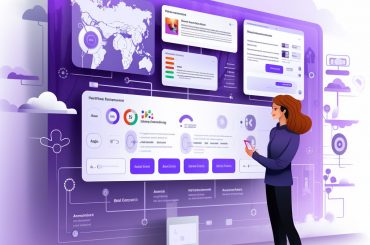Table of Contents
Planning, designing, creating, implementing, deploying, improving, and providing support for internal and external stakeholders are all included in IT Service Management (ITSM) which aims to continuously enhance services to best fulfill business objectives.
In order for the organization to achieve its long-term goals, ITSM makes sure the appropriate technology, procedures, and people are in place. Customer satisfaction is increased while service delivery quality and speed are improved via ITSM. Some companies use ITSM software to manage a variety of internal business processes and services in addition to managing and supporting their IT infrastructure.
What Is IT Service Management ITSM?
All the processes involved in planning, producing, delivering, supporting, and managing the lifecycle of IT services are collectively referred to as IT Service Management (ITSM).
Consider any technological device you use at work, such as your laptop, the applications you have loaded on it, the printers, or the ability to reset your password even after the first 15 attempts. All of these services are offered by your IT department. IT services, to put it another way.
Although “IT assistance” is the most popular misconception among IT users (workers), ITSM encompasses much more than handling basic problems. All aspects of these services must be managed by your IT department.
What are IT Service Management Solutions?
Theoretically, IT services apply to every piece of office equipment you use, including your computer, laptop, printer, copier, and even help if you constantly forget your password. IT services cover all of these things: maintenance, development, repair, updates, upgrades, and backup creation.
When discussing ITSM, users frequently refer to “IT Support”. In reality, ITSM encompasses much more than just solving basic business problems. For an IT team to manage services and components as effectively and efficiently as possible, they must have a thorough understanding of all of them.
What Is IT Service Management Consultant?
IT Service Management is a continuous process of managing all hardware, software and computing resources of a company. A reputable and experienced IT service management consulting helps your business by providing improved quality and speed of IT management services and their delivery.
A good ITSM consultancy will;
- Planning and implementing IT service management procedures customized for your organization’s particular IT infrastructure.
- Enhance your company’s incident command system, IT asset management, change management, and knowledge management.
- To structure and standardize IT processes, use an ITSM platform like ServiceNow® or Jira.
What Are IT Service Management Lifecycle And The Processes?
The 26 IT service management processes have been divided into 5 service lifecycle stages and form the foundation of IT service management (ITSM).
- Service Strategy
- Service Design
- Service Transition
- Service Operations
- Continual Service Improvement (CSI)
Let’s have a comprehensive look at each of these stages and discover how IT Service Management (ITSM) processes are mapped into them.
Service Strategy
This phase creates the framework or basis for an organization’s ITSM process development. It entails deciding what services the firm will provide, planning processes strategically, and identifying and creating the assets needed to keep processes going. Any organization’s service strategy should consider the following elements:
- Strategy management
- Service portfolio management
- Financial management
- Demand and capacity management
- Business relationship management
Service Design
The major objective of this stage is to plan and develop the IT services that the company provides to suit business expectations. It entails developing and designing fresh services as well as evaluating present offerings and making necessary upgrades. IT service design consists of the following components:
- Design coordination
- Service catalogue management
- Risk management
- Service level management
- Capacity management
- Availability management
- IT service continuity management
- Information security
- Compliance
- Architecture management
- Supplier management
Service Transition
It’s crucial to construct and test IT service designs as soon as they are complete in order to make sure that processes work as intended. Particularly when current IT service procedures are improved or redesigned, IT professionals need to make sure that the designs don’t interrupt services in any way. This necessitates the management of risk, appraisal, and change. There are always risks associated with transitions, so it’s critical to take preventative measures.
- Project management
- Knowledge management
- Service asset and configuration Management
- Release and deployment management
Service Operation
Implementing the tried-and-true new or updated designs in a real-world setting constitutes this phase. Although the procedures were previously tested and any problems have been resolved, new procedures are liable to experience glitches, particularly after customers begin utilizing the services. Therefore, IT professionals must keep a careful eye on workflows and procedures and take proactive measures to guarantee service continuity. The following are some of the important steps in the service operational phase as defined by the ITIL framework:
- Incident and request fulfilment management
- Problem management
- Technical management
Continual Service Improvement (CSI)
Any organization’s effective IT process implementation shouldn’t be the last step. Based on new problems that arise, client requirements and feedback, there is always room for progress. Metrics and key performance indicators (KPIs) are important in identifying areas that require adjustment or development. Read this blog post on the crucial KPIs for any firm for a better understanding. CSI has the following features, among others:
- IT service review
- Process evaluation
- CSI initiatives management
7 Best Practices IT Service Management Offers
When your IT department makes a few crucial decisions from strategy to execution and beyond, IT service management and service management, in general, operate at their best. Your service management approach can succeed if you follow these seven essential best practices.
- Assess your ITSM maturity and develop a well-defined plan to achieve your business objectives.
- Create self-sufficient self-service by automating tasks.
- Set up measurements and KPIs for your automation and service management strategies.
- Put the customer experience first and concentrate on adding value.
- Use a service catalog for IT
- Select a reliable service management tool.
- Assemble a service management team that is efficient
Conclusion
For people who want to pursue management or team leadership positions that require managing and collaborating with many teams, IT service management (ITSM) is particularly significant. All of the Service Lifecycle modules are appropriate for those who want to concentrate on the steps, components, and management skills needed to deliver high-quality service management practices.
Get Your ITSM Solution Started Now!





